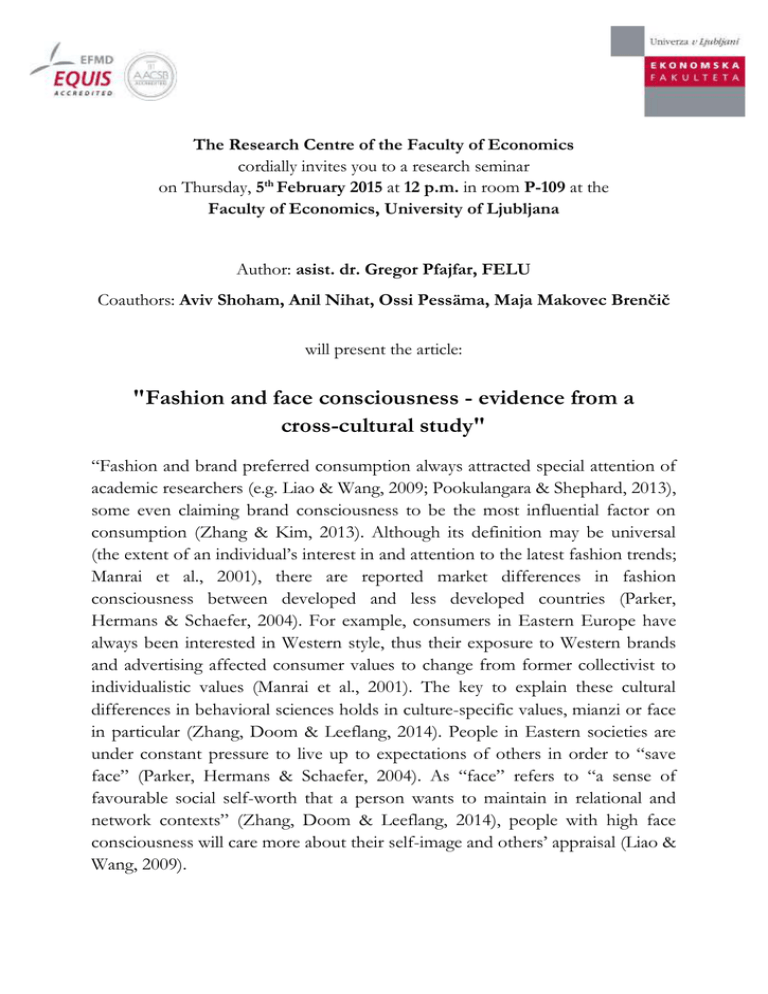Fashion and face consciousness - evidence from a
advertisement

The Research Centre of the Faculty of Economics cordially invites you to a research seminar on Thursday, 5th February 2015 at 12 p.m. in room P-109 at the Faculty of Economics, University of Ljubljana Author: asist. dr. Gregor Pfajfar, FELU Coauthors: Aviv Shoham, Anil Nihat, Ossi Pessäma, Maja Makovec Brenčič will present the article: "Fashion and face consciousness - evidence from a cross-cultural study" “Fashion and brand preferred consumption always attracted special attention of academic researchers (e.g. Liao & Wang, 2009; Pookulangara & Shephard, 2013), some even claiming brand consciousness to be the most influential factor on consumption (Zhang & Kim, 2013). Although its definition may be universal (the extent of an individual’s interest in and attention to the latest fashion trends; Manrai et al., 2001), there are reported market differences in fashion consciousness between developed and less developed countries (Parker, Hermans & Schaefer, 2004). For example, consumers in Eastern Europe have always been interested in Western style, thus their exposure to Western brands and advertising affected consumer values to change from former collectivist to individualistic values (Manrai et al., 2001). The key to explain these cultural differences in behavioral sciences holds in culture-specific values, mianzi or face in particular (Zhang, Doom & Leeflang, 2014). People in Eastern societies are under constant pressure to live up to expectations of others in order to “save face” (Parker, Hermans & Schaefer, 2004). As “face” refers to “a sense of favourable social self-worth that a person wants to maintain in relational and network contexts” (Zhang, Doom & Leeflang, 2014), people with high face consciousness will care more about their self-image and others’ appraisal (Liao & Wang, 2009). A call for a good measurement instrument for the face consciousness (Bao, Zhou & Su, 2003) led us to expand the set of proposed cultural dimensions elaborated in the previous literature to independence, power and social inequality as cultural-specific antecedents (these were selected as they are social norms highly rooted in the culture) to face consciousness. We believe that fashion is a good proxy of culture. Thus, our goal is to propose a new model, evaluating the interconnectivity between face consciousness, interpersonal influence, fashion consciousness and brand consciousness. We claim that fashion is determined by our cultural orientations and is strengthened by how we communicate through others and our brands. The results are based on multicountry data from Slovenia, Israel and Turkey. Altogether 535 consumers’ responses were included in the analysis. Structural equation modeling was used to test the model. The data supported the model in all three countries. Face consciousness was proven to have a significant positive relationship on fashion consciousness to the highest extend in Turkey and on brand consciousness in Israel. Contrary to our expectations, independence and its expected positive relationship on face were not supported in any of the three countries. The value of this paper is that it posits face and fashion consciousness under the loop of different cultural communication antecedents, offering important implications for cross-cultural research.” You can register for the free seminar by phone (01) 58-92-490, or via e-mail: research.seminars@ef.uni-lj.si by Wednesday, 4th February 2015. We look forward to seeing you!






